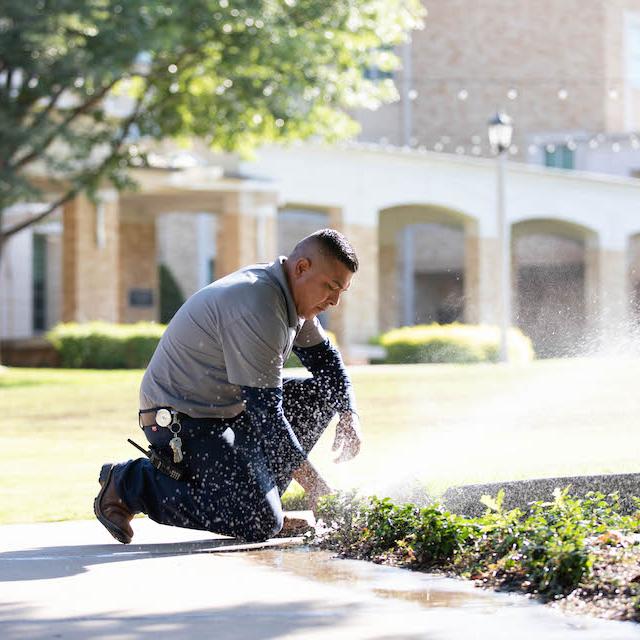
TCU Facilities Keeps the Campus Grounds Beautiful … Through Drought and Storm
This summer’s searing heat and record temperatures left yards and flower beds across North Texas struggling to survive. But at TCU, the landscaping and grounds team kept the campus looking green and healthy, thanks to skillful soil and irrigation management – and a lot of planning.
“We only water when the city’s watering schedule allows, which is two times a week,” Erik Trevino, director, said. “We water deeply on those days, and the grass and plants we have are trained to survive on that.”
In addition to planning the right types of grass planted according to conditions – mainly based on sun exposure but also level of foot traffic – the team is always watching the weather.
“Every day, we talk about the weather so we can determine water settings and actively manage the sprinklers so we’re not running them in the rain.”
While rain delays weren’t an issue this summer, drought was. Trevino credited the current verdant conditions to past selections of hardy plants and grasses that now have established root systems. He also recognized the team of 50 who maintain the acreage for their expertise, especially with the delicate balance of watering – not enough and lawns can quickly turn brown, too much leads to disease.
“We have a long-tenured grounds team that keeps our campus looking great,” Trevino said. “It’s not just about pushing a mower. We’re passionate about the grounds being something for everyone to enjoy, including those in the community who drive by and walk through it.”
One of the campus’ most distinctive green spaces is the canopy of trees on University Drive. Trevino, a certified arborist, said crews only prune trees across campus as needed, for safety and aesthetics. There are about 3,200 trees on TCU’s 300-plus acres and of a variety of species. That diversity is important to guard against a disease wiping out large numbers.
“Trees are one of our most important assets, and mature trees can’t be replaced,” he added. “They create shade for cooling and encourage students to walk instead of drive.”
Either as they walk or drive along TCU’s main streets, students and others frequently comment on the beautifully maintained flower beds. These are changed out with the seasons and while they may be some of the most pampered plants on campus, their showy display of purple and white are why they are in high-profile locations. Ever since the Mary Evans Beasley Endowment for Campus Beautification was established in 1987, TCU's grounds have been even more beautiful.
As water increasingly becomes a scarcer resource, Trevino is looking to include more adaptive plants into the landscape. He also encourages the team to take cuttings from existing plants to grow in the university’s greenhouse for future landscaping.
Other sustainability practices include separating green waste for composting and using organic fertilizer. Future plans are to incorporate more drip irrigation systems as well as establish plants that attract pollinators.
The campus sustainability committee, including students, shares ideas with Trevino and team. One of their annual activities is Texas Arbor Day, held the first Friday in November.
“We’ll have a tree planting and some educational opportunities,” Trevino noted of this year’s event, which is part of TCU’s multi-year certification as a Tree Campus USA. Also available is a self-guided audio tour about the campus trees on TCU’s website.
“Engaging students is important. When you connect with nature, you find harmony. A peaceful environment is one where we can all thrive.”
